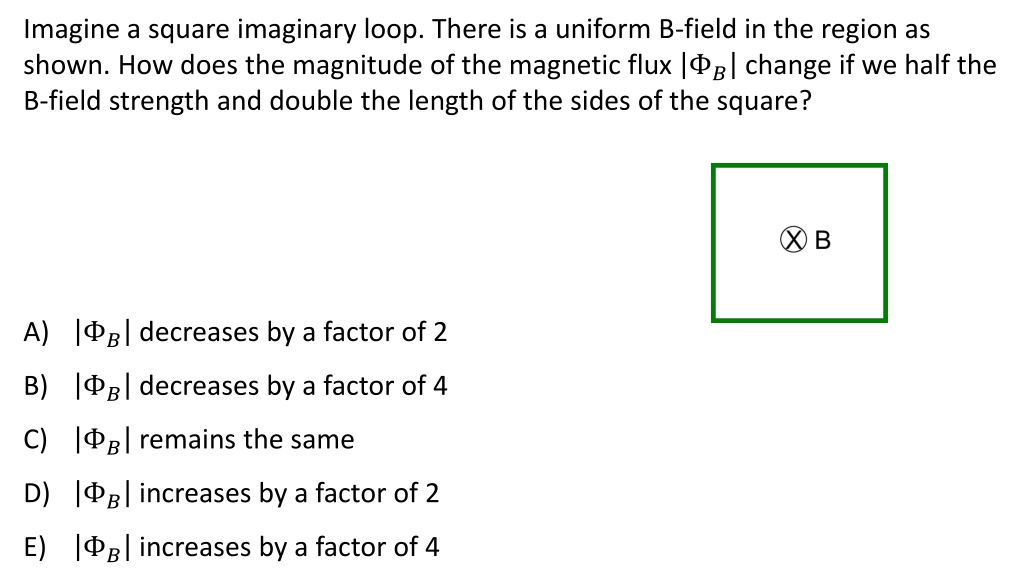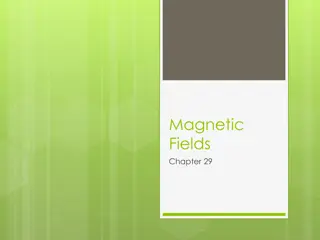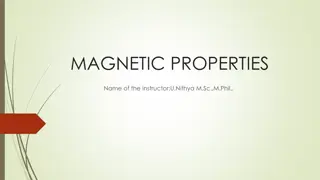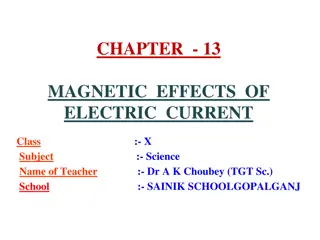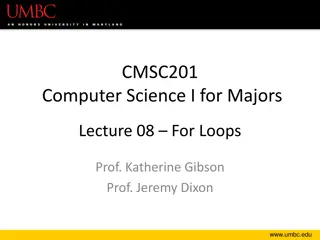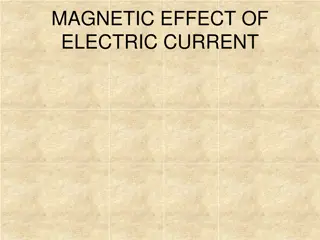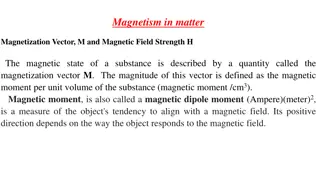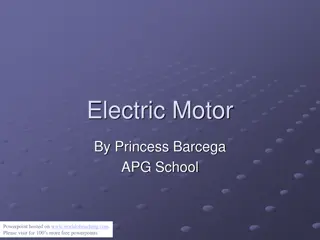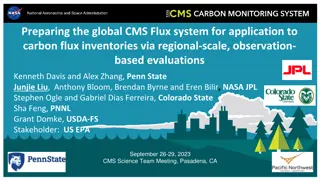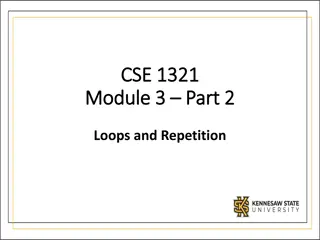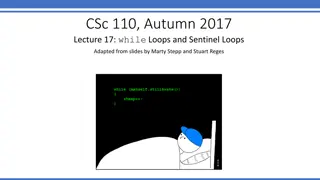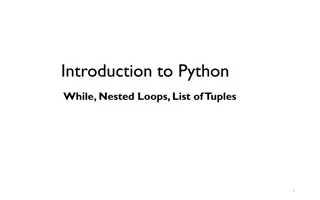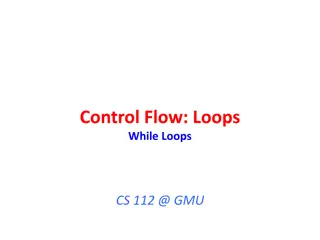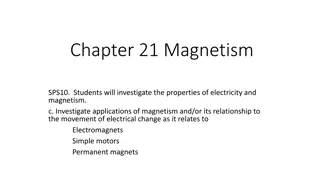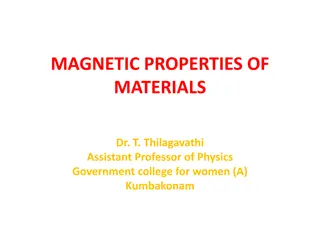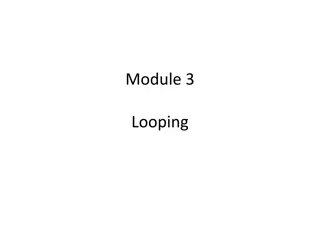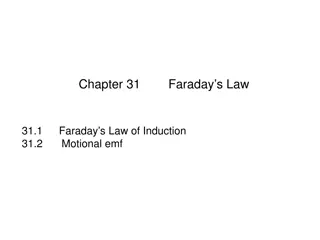Understanding Magnetic Flux and Induced Current in Loops
Explore concepts related to magnetic flux and induced current in loops through visual scenarios involving uniform magnetic fields, loop movements, and changes in magnetic flux. Test your understanding with multiple-choice questions on induced EMF, loop bending, and maximizing magnetic flux. Enhance your knowledge of electromagnetic principles with engaging illustrations.
Download Presentation

Please find below an Image/Link to download the presentation.
The content on the website is provided AS IS for your information and personal use only. It may not be sold, licensed, or shared on other websites without obtaining consent from the author. Download presentation by click this link. If you encounter any issues during the download, it is possible that the publisher has removed the file from their server.
E N D
Presentation Transcript
Imagine a square imaginary loop. There is a uniform B-field in the region as shown. How does the magnitude of the magnetic flux ? change if we half the B-field strength and double the length of the sides of the square? ? decreases by a factor of 2 A) ? decreases by a factor of 4 B) ? remains the same C) ? increases by a factor of 2 D) ? increases by a factor of 4 E)
A loop of wire is moving rapidly through a uniform magnetic field. Is a non-zero current induced in the loop (assuming it remains within the region of the field)? A) Yes, there is B) No, there is not
A loop of wire is spinning rapidly about a stationary axis in a uniform B- field. Is a non-zero current induced in the loop? A) Yes, there is B) No, there is not
What if that loop were spun around an axis oriented perpendicular to the plane of the page, running through the center? Is a non-zero current induced in the loop? A) Yes, there is B) No, there is not
What if that loop were spun around an axis oriented perpendicular to the plane of the page, running through the center? Is a non-zero current induced in the loop? A) Yes, there is B) No, there is not
In order to change the magnetic flux through the loop, what would you have to do? A) Drop the magnet B) Move the magnet upward C) Move the magnet sideways D) Only A) or B) will work E) A), B), or C) will work
The magnetic flux through a loop of wire is shown. At which time is the magnitude of the emf induced in the loop a maximum? flux D C time B A A) A B) B C) C D) D E) same at all times
A loop of wire is sitting in a uniform, constant magnet field as shown. Suddenly, the loop is bent into a smaller area loop. During the bending of the loop, there will be an induced EMF that will create an induced current in the loop. This induced current will create a magnetic field in the loop that is A) Left B(in) B(in) B) Right C) Into the board D) Out of the board
A loop of wire is sitting in a uniform, constant magnet field as shown. Suddenly, the loop is bent into a smaller area loop. We have decided that the induced current will create a magnetic field in the loop that is into the board. Which direction must the induced current be flowing? B(in) B(in) A) Clockwise B) Counterclockwise
A square metal loop moves at constant velocity v through a region with a magnetic field directed into the page. At which point(s) does the induced current in the loop flow clockwise? A) 2 B) 3 C) 4 D) both 2 and 4
A horizontal loop of wire is in a vertical magnetic field. (caused by an external magnet). The magnetic field varies smoothly from pointing upward to pointing downward, as shown. (The B-field gradually gets smaller, goes to zero, then grows in the other direction.) At the moment when the external magnetic field in the loop is zero, is there an induced current in the loop? A) Yes B) No
A horizontal loop of wire is in a vertical magnetic field. (caused by an external magnet). The magnetic field varies smoothly from pointing upward to pointing downward, as shown. (The B-field gradually gets smaller, goes to zero, then grows in the other direction.) At the moment when the external B-field in the loop is zero, what is the direction of the induced current? A) Clockwise (as seen from above) B) Counterclockwise (as seen from above) C) No direction because the induced current is reversing direction
A loop of wire is moving rapidly through a uniform magnetic field as shown. The induced current in the loop flows ? A) Clockwise B) Counterclockwise C) There is no induced current
A coil of wire attached to a resistor is in an oscillating magnetic field, as shown. The B-field vs. time is shown. At what point in time is the magnitude of the current through the resistor a maximum? A) don t choose this (B) B) B (C) B-field (T) C) C 0 (D) D) D (E) E) E time
A circuit with a battery and a variable resistor is near a loop of wire as shown. When the resistance R is decreased, the induced current in the loop is A) Clockwise (CW) B) Counterclockwise (CCW) C) Zero
A loop of wire sits in a uniform B field (shown) which is steadily increasing in magnitude. The current induced in the loop is A) Clockwise (CW) B) Couterclockwise (CCW) C) No induced current
A loop of wire sits in a uniform B field (shown) which is steadily increasing in magnitude. Lenz s law tells us that the induced current will flow counterclockwise. Once it starts flowing, this induced current will feel a force (due to the external B) that A) tries to move the loop out of the page. B) tries to move the loop into the page. C) tries to expand the loop (stretch it out, increasing its radius). D) tries to contract the loop (shrink it, decreasing its radius).
A bar magnet is positioned below a horizontal loop of wire with its North pole pointing toward the loop. Then the magnet is pulled down, away from the loop. As viewed from above, is the induced current in the loop clockwise or counterclockwise? eyeball N B) counter- clockwise A) clockwise S
A magnet falls towards a conducting ring. As it falls, a current is induced in the ring. Does this induced current A) have no effect on the magnet B) repel (hold up) the magnet C) attract (pull down) the magnet
A long, straight wire carrying an increasing current I passes along a diameter of a wire loop. The straight wire and the loop are in the same plane but are not in electrical contact. The induced current in the loop is A) zero B) counterclockwise C) clockwise
The drawing shows a top view of two circular coils of conducting wire lying on a flat surface. The centers of the coils coincide. In the larger coil there is a switch and a battery. The smaller coil contains no switch and no battery. Describe the induced current that appears (or not) in the smaller coil when the switch in the larger coil is closed. A) It flows counterclockwise forever after the switch is closed B) It flows clockwise forever after the switch is closed C) It flows counterclockwise, but only for a short period just after the switch is closed D) It flows clockwise, but only for a short period just after the switch is closed
A metal bar moves with speed v in a region where there is a uniform magnetic field as shown. How do the charges separate inside the copper bar as it is moved through a region of uniform magnetic field?
A metal bar (not attached to any outside circuitry) is moving through a uniform magnetic field as shown. The electric field E within the bar is A) non-zero and downward B) non-zero and upward C) zero
What is the magnitude of the potential difference from the top to the bottom of the rod (length ?)? A) qvBL B) BL C) vBL D) 2vBL E) zero
While the rod slides right, what is the magnetic force on the sliding rod? A) Left B) Right C) Up D) Out of the page E) No magnetic force
A conducting loop is halfway into a magnetic field. Suppose the loop is given a quick push to the left so that the flux through the loop begins to increase. Which direction is the induced current? A) Clockwise B) No induced current C) Counterclockwise
We have seen that the quick push to the left caused a counterclockwise induced current. If this push is not sustained, what happens to the loop? [Assume the loop is large so that it remains only partially in the region of magnetic field] A) It accelerates to the left B) It moves with constant speed to the left C) It slows down to a stop D) It slows down to a stop and then accelerates to the right
A uniform solid sphere of copper rotates about a stationary axis in a uniform magnetic field B. Are there eddy currents? A) Yes, there are eddy currents. B) No, there are no eddy currents.
Inductor 1 consists of a single loop of wire. Inductor 2 is identical to inductor 1 except that it has two loops. How do the self-inductances of the two loops compare? A) ?2= 2?1 B) ?2> 2?1 C) ?2< 2?1
Current is flowing through an inductor (only part of the circuit is shown). A voltmeter measures ??> ??. Which of the statements could be true? A) Current is flowing from a to b and is steady. B) Current is flowing from a to b and increasing. C) Current is flowing from a to b and decreasing. D) Current is flowing from b to a and steady. E) Current is flowing from b to a and increasing.
An LR circuit is shown below. Initially the switch is open. At time t=0, the switch is closed. What is the current through the inductor L immediately after the switch is closed (time t=0+ )? A) Zero B) 1 A C) 0.5 A D) 2 A E) none of these
An LR circuit is shown below. Initially the switch is open. At time t=0, the switch is closed. After a long time, what is the current through the battery? A) Zero B) 1 A C) 0.5 A D) 2 A E) none of these
Now suppose the switch has been closed for a long time and is then opened. Immediately after the switch is opened, the current through ?2is A) zero B) not zero
The switch in the circuit below is closed at t=0. What is the current through the resistor immediately after the switch is closed? A) 0 A B) 0.5 A C) 1 A D) 10 A E) none of these
The switch in the circuit below is closed at t=0. What is the initial rate of change of current dI/dt in the inductor, immediately after the switch is closed? [Hint: what is the intial voltage across the inductor? A) 0 A/s B) 0.5 A/s C) 1 A/s D) 10 A/s E) none of these
The circuit shown has two resistors, both with resistance R, an inductor with inductance L, a battery with constant voltage V, and a switch which can be in position A or B. Suppose the switch has been in position A for a long time and is then switched to position B. Immediately after the switch is thrown to B, what is the current in the inductor? A) zero B) V/R C) V/(2R) D) 2V/R E) None of these
The circuit shown has two resistors, both with resistance R, an inductor with inductance L, a battery with constant voltage V, and a switch which can be in position A or B. Suppose the switch has been in position A for a long time and is then switched to position B. Immediately after the switch is thrown to B, what is the voltage across the inductor L? A) zero B) V C) 2V D) V/2 E) None of these
The same current I is flowing through solenoid 1 and solenoid 2. Solenoid 2 is twice as long and has twice as many turns as solenoid 1, and has twice the diameter. What is the ratio of the magnetic energy contained in solenoid 2 to that in solenoid 1, that is, what is ?2 ?1? [Hint: for a solenoid B = o n I ] A) 2 B) 4 C) 8 D) 16 E) none of these
Two long solenoids, each of inductance L, are connected together to form a single very long solenoid of inductance Ltotal. What is Ltotal? A) 2L B) 4L C) 8L D) none of these
A long solenoid of radius R has an increasing current causing an increasing B- field in its interior. An end-on view of the solenoid is shown below. A student wishes to compute the E-field outside the solenoid at a distance r (r > R) from the center. She applies Faraday s Law in the form, ?? ? ? = where A is the area bounded by the (imaginary) loop L of radius r. ? ?? ?? ?? , Is there a non-zero E-field outside the solenoid? A) No, E=0 outside the solenoid B) Yes, the E-field circulates CCW C) Yes, the E-field circulates CW D) Yes, there is a radial E-field
? ?? ?? ?? = ? ???? = ??? The student begins by writing ?? What is the correct expression for A? A) ??2 B) ??2 C) 4??2 D) 4??2 E) none of these
? ?? ?? ?? = ??2?? We have seen that ?? ? ? = ?? For distances ? > ? from the center of the solenoid, how does the magnitude of the induced electric field depend on r? A) ? = 0 B) ? 1/? C) ? ? D) ? ?2 E) ? ?3
Now suppose the path is insidethe solenoid (she is trying to find the electric field at positions where r < R). How does the magnitude of the induced electric field depend on r? A) ? = 0 B) ? 1/? C) ? ? D) ? ?2 E) ? ?3
The graph shows the current as a function of time for an electrical device plugged into a outlet with an rms voltage of 120 V. What is the resistance of the device? Hint: 1 2 0.7 A) 24 B) 21 C) 17 D) 14 E) 12 Time (s)
You are building an LC oscillator circuit and you would like to maximizethe oscillator s frequency. Which components should you choose? A) ? = 100 ?H , C = 10 ?F B) ? = 10 ?H , C = 100 ?F C) ? = 100 ?H , C = 100 ?F D) ? = 10 ?H , C = 10 ?F
The current in an oscillating LC circuit is zero. Which one of the following statements is true? A) The charge on the capacitor is equal to zero coulombs. B) Charge is moving through the inductor. C) The energy is equally shared between the electric and magnetic fields. D) The energy in the electric field is maximized. E) The energy in the magnetic field is maximized.
An ac voltage source ? ? = ?0sin(??) is connected to a resistor. What is the average power dissipated by the resistor? A) zero B) positive C) negative D) not enough information
A 100 W light bulb (average power) is attached to a wall plug (120 V rms, 60 Hz). What is the peak power output to the bulb? A) 100 W 2 100 W B) C) 200 W D) none of these
A resistor with resistance R is plugged into a 120 V AC wall socket. The graph below is either voltage V across, current I thru, or power P dissipated in the resistor vs. time. What could the graph be? A) V only B) I only C) V or I only D) V, I, or P E) Some other combination
A transformer is connected to a battery as shown. The voltage across the resistor R is V N2 N1 R iron core A) ??2 ?1 B) ??1 ?2 C) ? D) zero E) not enough information to answer
